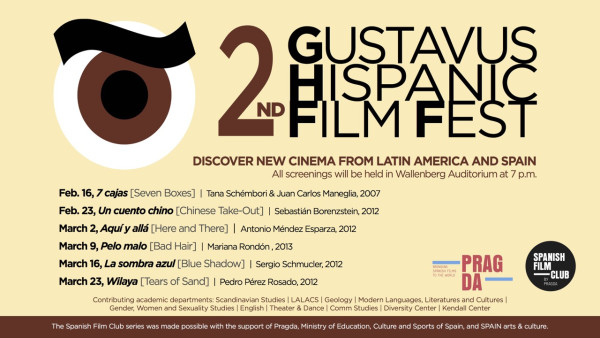Gustavus Adolphus College provides students and community members with opportunities to view different cultures through a variety of mediums. The College is currently hosting its second Hispanic Film Festival during six weeks of February and March. The festival is free and open to the public, featuring screenings of six films from different Hispanic countries and directors. The films will be shown in the Wallenberg Auditorium at 7 p.m. on six successive Mondays beginning on Feb. 16 and ending on March 23.
The Festival kicked off with 7 cajas (Seven Boxes), directed by Tana Schémbori and Juan Carlos Maneglia in Paraguay, 2007. Similarly to the weekend movies that are also held in Wallenberg, the event was complete with free popcorn.
Junior Spanish and Latin American Studies major Emma Jasnoch is involved with the film festival. Students like Jasnoch in the Spanish course are in charge of presenting a movie to campus, making brochures, and participating in panel discussions after the screenings.
“It’s a really unique opportunity to learn more about Hispanic culture,” Jasnoch said. “It’s to give the school and the students some exposure to Hispanic culture as represented through film. I think that it’s good for people to know that Hollywood isn’t the only source of film in the world and that the other countries that are producing these films have their own unique ways of expressing their culture, and you can learn a lot about them through their movies.”
In addition to screening the films, two of the directors will be visiting campus for the film festival. Antonio Méndez Esparza, director of Aquí y allá (Here and There), will be Skyping in to the event. The director of La sombra azul (Blue Shadow), Sergio Schmucler, will be attending the festival. Schmucler will also be visitng Gustavus later on for a script writing mini-course.
Junior Psychological Science and Spanish major Travis Sigafoos is the academic assistant for the Spanish program. Sigafoos is looking forward to the opportunity to have the directors present for the screenings.
“It is great to see how the Hispanic Film Festival can bring the campus together to appreciate the diverse cultures that are portrayed in these films and to engage in thoughtful discussion of the current events in Spain and Latin America,” Sigafoos said.
This year, a new logo depicting an eye was designed for the event. This image represents looking, discovering, and seeing new things.
Darío Sánchez-González, assistant professor in Modern Languages, Literature and Cultures, Spanish, and Gender, Women, and Sexuality Studies, is one of the organizers of the event.
“It is important to expose students to a wide number of cultural expressions,” Sánchez-González said. “We have movies at Gustavus, but we oftentimes lack more daring and independent films, the stuff that students should see. Anyone who comes to see the movies will find them to be enticing, daring, and attractive, and at the same time very entertaining.”
The event first began in 2013 and will continue to be held biannually. The film festival is sponsored by many departments and organizations on campus including Modern Languages, LALACS, Literature and Cultures, the Diversity Center, Peace Studies, and others. The event is also supported by PRAGDA, the Ministry of Culture of Spain, and the organization’s Program for Cultural Cooperation with United States’ Universities. PRAGDA was created to “promote, disseminate, and maintain the legacy of Spanish and LAtin American Cinema through unique cultural initiatives.” For more information about PRAGDA, visit the organization’s website.
“It’s great to see the different departments supporting this event,” Sánchez-González said. “It’s not just our event, but also an event of the larger Gustavus community.”
For a full schedule of the event and a synopsis of the films visit the Gustavus website.
-Kim Krulish
